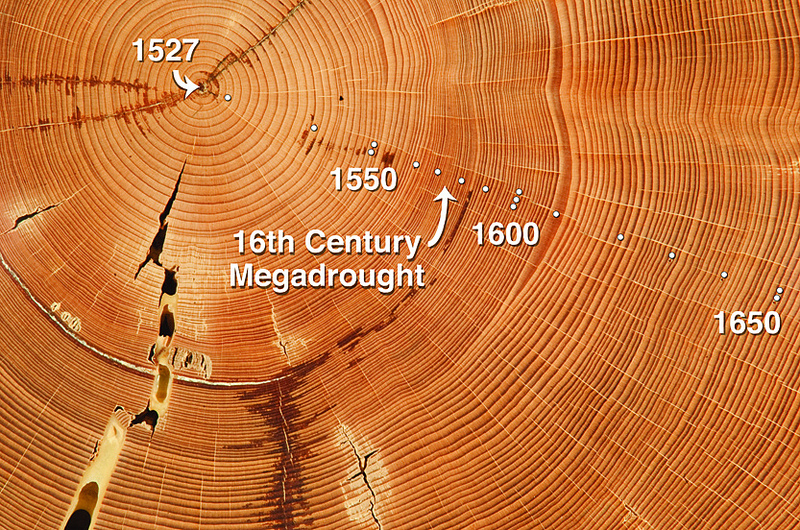Please note: Osher Rainforest will be closed for maintenance Jan. 14–16.
Science News
Trees’ Bleak Future
October 23, 2012
by Zuberoa Marcos

(Scroll down for Spanish version)
The world’s trees are facing serious challenges as the climate warms, especially in the Southwestern United States. Last February, a report from Texas A&M Forest Service determined that 2011’s drought killed more than 300 million trees in Texas forests and another 5.6 million trees in Texas cities.
Then, last month, a study published in Nature Climate Change concluded that if current climate trends continue, forests in the Southwest will die out at an accelerating rate. And not just from drought, but also from invasions of tree-eating pests and more destructive forest fires tied to climate change.
To figure out how climate variables affect forests, the researchers combined 13,000 tree core samples ring records with historical information and temperature and moisture data collected in the Southwest since the late 1800s. The scientists identified the total winter precipitation and the average summer-fall atmospheric evaporative demand as the two climate variables that most determine Southwestern tree-growth variability.
Precipitation, okay, but what is “atmospheric evaporative demand”? Lead author A. Park Williams of Los Alamos National Laboratory in New Mexico explains, “Atmospheric evaporative demand is primarily driven by temperature. When air is warmer, it can hold more water vapor, thus increasing the pace at which soil and plants dry out. The air literally sucks the moisture out of the soil and plants.”
During the past 1,000 years, severe mega-drought events have occurred in the Southwest. The strongest one took place during the second half of the 1200s and is believed to have played an important role in the abandonment of ancient Pueblo cultural centers throughout the Southwest. The most recent mega-drought occurred in the late 1500s and appears to have been serious enough to kill many trees in the region.
“When we look at our tree-ring record, we see that in the 1580s all the tree rings are really tiny. After the 1500s mega-drought, tree rings get wider, and there was a major boom in new trees,” says Williams.
Will droughts in the 21st-century reach or exceed those of the 1200s and 1500s? Temperatures have been increasing in Southwest for the past century and are expected to continue due to accumulating greenhouse gases in the atmosphere.
Sadly, using climate-model computer projections, the team concluded that ancient drought conditions will exceed those earlier dry spells regularly by the 2050s. Bad news for the trees.
Zuberoa Marcos is a former biologist and current science writer based in Barcelona. She writes articles regularly for Science Today.
El negro futuro de los árboles
Por Zuberoa Marcos
Los árboles se enfrentan a graves problemas conforme el clima se calienta. En febrero pasado, un informe del Servicio Forestal Texas A&M afirmaba que, en 2011, la sequía acabó con más de 300 millones de árboles en los bosques de Texas y mató a otros 5,6 millones de árboles más en las ciudades de Texas.
El pasado mes de septiembre, un estudio publicado en la revista Nature Climate Change concluyó que si las tendencias climáticas actuales se mantienen, los bosques del suroeste de Estados Unidos se extinguirán a un ritmo acelerado. Y no sólo por la sequía, sino también por las invasiones de plagas e incendios muy destructivos ligados al cambio climático.
Para averiguar cómo el clima afecta a los bosques, los investigadores combinaron el registro de anillos de 13.000 muestras de núcleos de árboles con información histórica y datos de temperatura y humedad recogidos en el suroeste de EE.UU desde finales de 1800. Los científicos concluyeron que la precipitación total en invierno y el promedio de evaporación de agua en verano y otoño son las dos variables climáticas más que determinan el crecimiento de los árboles en la región.
"La demanda evaporativa depende de la temperatura. Cuando el aire es más cálido aumenta el ritmo al que el suelo y las plantas se secan porque el aire chupa, literalmente, la humedad de la tierra y de las plantas", explicó A. Park Williams, autor principal del artículo e investigador en el Los Alamos National Laboratory en Nuevo México.
Durante los últimos 1.000 años severas sequías han ocurrido en el suroeste de Estados Unidos. La más intensa fue durante la segunda mitad de los años 1200s y se cree que jugó un papel importante en el abandono de pueblos indios en toda la región. La mega-sequía más reciente sucedió en los años 1500 y parece que fue lo suficientemente intensa como para matar a muchos árboles en la zona.
"Cuando nos fijamos en el registro de anillos de los árboles, vemos que alrededor de 1580 todos los anillos son realmente estrechos A partir de los años 1500s, no sólo son más anchos, sino que nacieron muchos árboles nuevos", dijo el profesor Williams .
¿Las sequías inducidas por el cambio climático del siglo XXI alcanzarán o superarán a las de los años 1200 y 1500? Las temperaturas han aumentado en el suroeste de Estados Unidos durante el siglo pasado y se prevé que continuarán haciéndolo debido a la acumulación de gases de efecto invernadero en la atmósfera. Usando modelos climáticos informáticos el equipo llegó a la conclusión de que las condiciones de sequía de los siglos XIII y XVI serán superadas con regularidad en la década de 2050. El estudio prevé que durante la segunda mitad de este siglo, en alrededor del 80% de los años se registrarán niveles de sequía más elevados que antaño, creando un escenario sombrío para la supervivencia de los bosques. El futuro de los árboles pinta negro, muy negro.
Zuberoa Marcos es bióloga molecular y actualmente trabaja como productora de TV y periodista científica. Escribe de forma regular para Science Today.